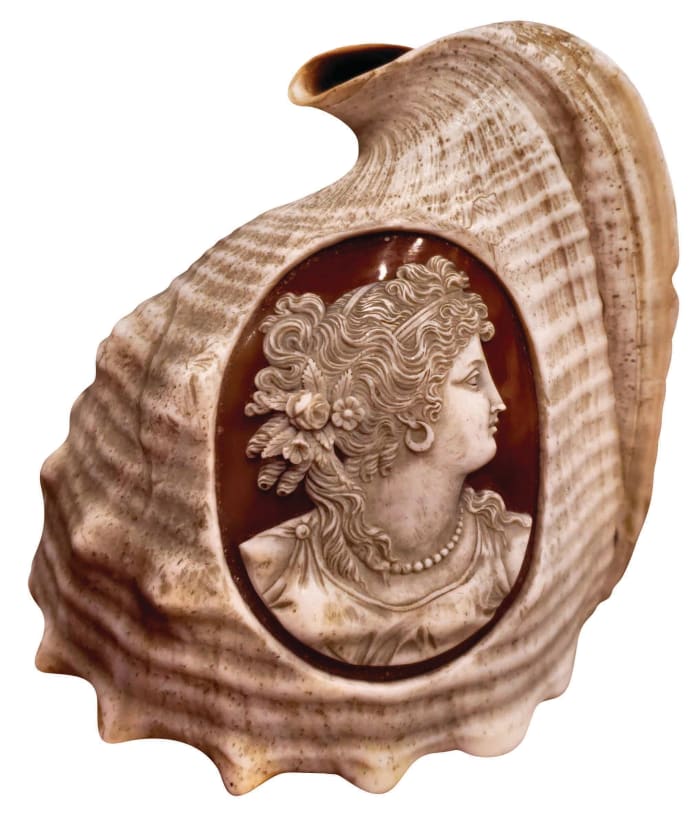#Faces #Give #Clues #Cameo #Jewelry #Age #Materials
I have encountered many origins of the word “cameo” and find little basis in most. One origin states the word “cameo” is Italian for “engrave.” I am not aware of any Italian word for “engrave” or “carve” or “scratch” that even closely resembles the word “cameo.”
The Italian word for cameo is cammeo. Other sources have indicated the word “cameo” is derived from the old French word camaieu or the old Latin word cammaeus, or khamea from the ancient Arabic word for amulet.
While the origins of the word may yet remain a mystery, the history of cameos and their popularity are well documented.
The shells most prized for carving cameos are those with naturally occurring layers of contrasting color. Shown here is a cameo carved into a kameynye shell, from the collection of author and historian Carol Greene.
Image courtesy of Dr. Anthony Cavo
Roman author and philosopher Pliny the Elder (23 to 79 A.D.) wrote about glass cameos as costume jewelry for those who could not afford cameos carved from gems or semiprecious stones such as agate.
Cameos, however, were known long before Pliny’s time. The ancient Egyptians and Mesopotamians carved cameos as long ago as five thousand years; these were carved in stone and later composed of glass.
Shell cameos, relatively new in the history of cameos, became popular six- to seven-hundred years ago during the Renaissance but the height of their popularity occurred during the Victorian era. Victorians, especially British Victorians, were enamored of Italy and all things Italian including cameos. Travelers to Italy bought and wore cameos as a sign of their status.
Victorian cameos
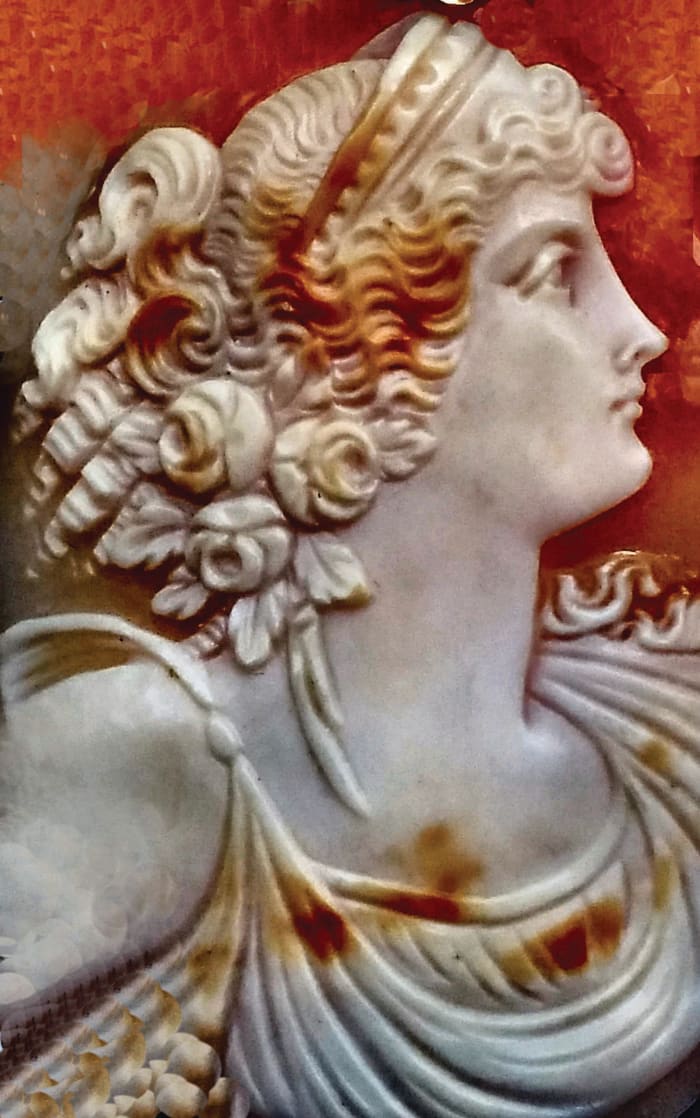
The finer the features and sharper and deeper the detail, the better the cameo.
Image courtesy of Dr. Anthony Cavo
The vast majority of Victorian cameos depict the profile of a woman with intricately arranged hair and possibly a diamond. Cameos depicting women with jewelry such as a necklace, bracelet, earring or diadem are known as habillé, which means “dressed,” “clad” or “dressy.” Habillé cameos became popular during the 1840s.
For wealthy English Victorians the “Grand Tour” was de rigueur and Italian cameos were the one must-have item with which they returned home. In a very short amount of time the English no longer had to travel to acquire cameos, which were imported, unmounted, into England by the thousands.
Even Queen Victoria succumbed to the beauty of cameos and routinely wore them, and what Queen Victoria did, everyone did – on both sides of the Atlantic Ocean. No middle- or upper-class woman’s accessories were complete without a cameo of some type.
Cameos during and before the Victorian era displayed allegorical, mythological, historical or religious images. Gods and goddesses, rulers, historic scenes, biblical scenes, Roman soldiers and beautiful women were subjects for cameos, which were worn by men and women. Later, during the Victorian era, cameos depicting a female’s profile were favored and worn by men as watch fobs, stickpins, rings and cuff links while women wore cameos as brooches, rings, earrings, pendants, and bracelets.
Cameo composition
Originally the word “cameo” referred to relief images of contrasting color but today include single-color pieces made of onyx, coral, carnelian, jet, ivory, bone, turquoise, amethyst, malachite, mother of pearl and lava, which is not actually lava but gray, brown, white or putty-color igneous rock such as felsite, rhyolite, basalt, or andesite.
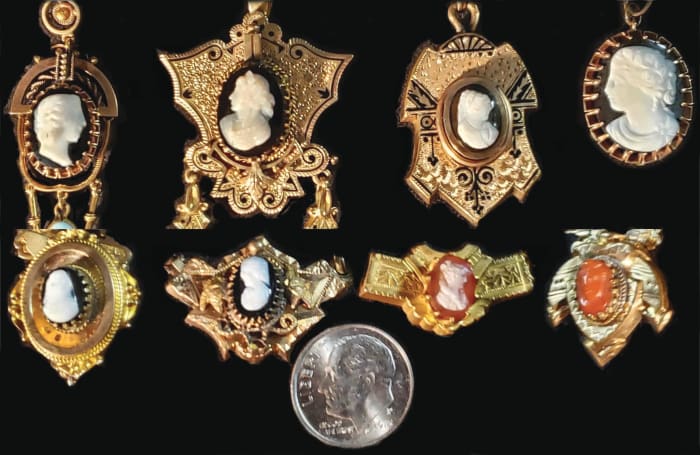
Many hardstone cameos are found in the white/black variety, with a cameo of white on a black background. Hardstone cameos are characteristically not as large as shell cameos with the majority being in the dime- to nickel-size. The first six cameos are cut from hardstone, the seventh is sardonyx shell and the eighth is coral. These necklaces are from the early to mid-Victorian era, mounted in gold; two with taille d’epargné.
Image courtesy of Dr. Anthony Cavo
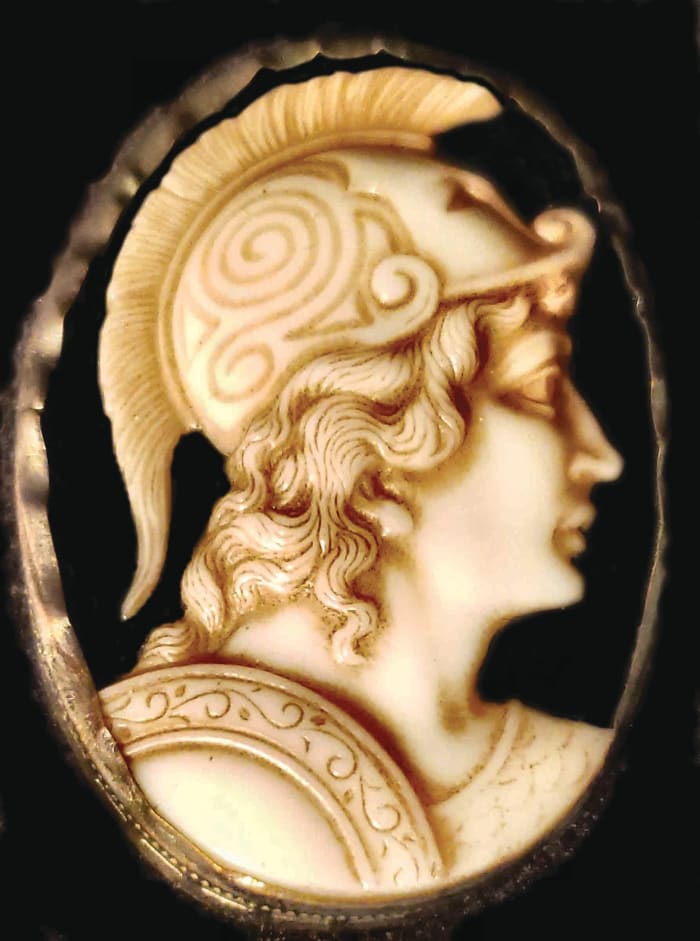
This late 18th or early 19th century glass cameo depicts the head of a Roman soldier, which was an early favorite theme in cameos. The cameo is made of two layers of contrasting glass with a yellowish-brown profile on a black background.
Image courtesy of Dr. Anthony Cavo
Glass, hardstone, and shell are the most common materials used for cameos with shell, surprisingly, rather recent in the historical timeframe; glass and stone cameos being the oldest form.
Glass cameos were formed by pouring molten glass into an intaglio mold, which was typically made of clay. The glass could be poured in layers of different colors to be carved once it cooled or otherwise carved from a single-color glass then mounted on glass background of contrasting color.
Glass cameos enjoyed a revival during the twentieth century and are extremely valued by collectors today, especially those made by recognized designers like Hobe, Bellini, Neiger, Whiting & Davis and Juliana.
Most twentieth century glass cameos are made with the use of modern molds and, as such, will bear mold lines or dimples and ridging along the back as well as the absence of angles and planes that result from hand carving.
Coral and stones like malachite, amethyst, turquoise, and lava result in monochrome cameos that may be favored by some but that are far less popular than varicolored cameos made of shell and hardstone.
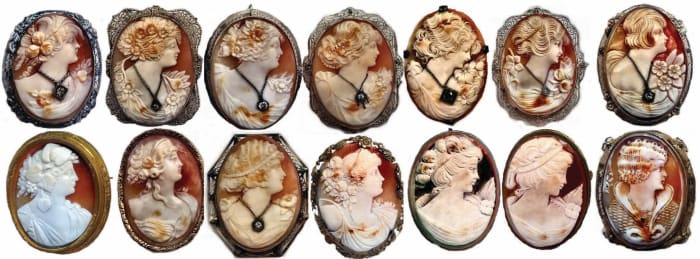
Progression of shell cameos from the late 19th century to the 1920s; the two at the far right with typical hairstyles from the 19-teens to the 1920s. Of importance to note is the change in the shape of the face and nose – important distinctions when attempting to date cameos. Cameos with round cheeks and aquiline or Roman noses (those with a prominent bridge), are usually of 19th century origin, whereas cameos with prominent cheekbones and pug or turned-up noses, originate in the 20th century. It is also important to note the type of fastening used to pin the brooch to clothing. Nineteenth century brooches have a C-clasp and pins that stick out beyond the side of the brooch, as seen in the cameo in the bottom row, far left. If you place a brooch, face-up, on a flat surface and are able to see the pin protruding beyond the bezel and it has a C-clasp, then it is almost surely from the first three quarters of the 19th century.
Image courtesy of Dr. Anthony Cavo
Hardstone cameos are usually composed of a form of semi-precious stones including all types of chalcedony: agate, aventurine, bloodstone, carnelian, chrysoprase, jasper, onyx, tiger’s eye, sard and sardonyx. Banded agate, which is multicolored, and sardonyx, which has parallel bands of brown to red alternating with white or black bands, are favored.
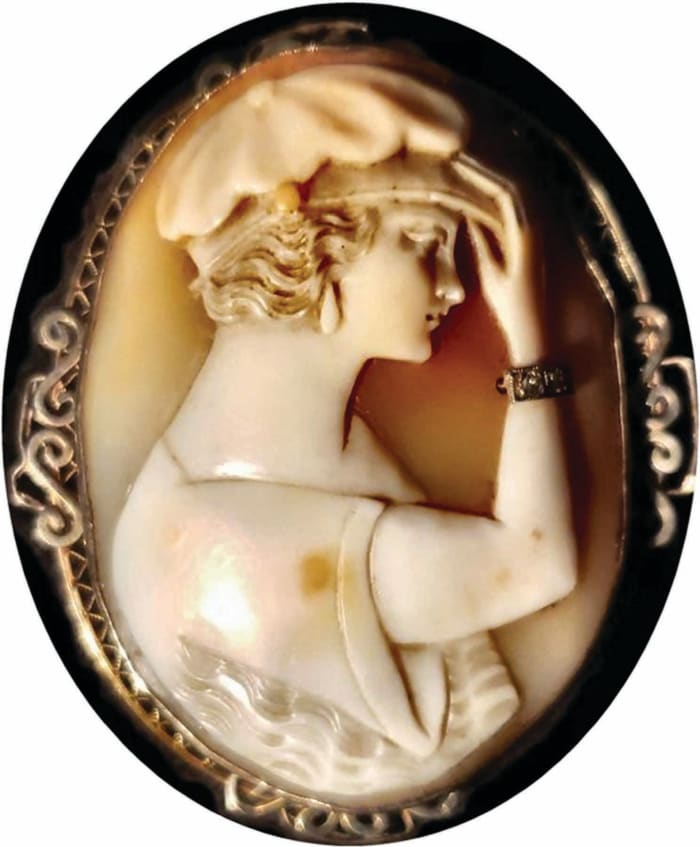
Unusual cameos are prized by collectors. Portrait cameos of individuals who can be identified are difficult and exciting to find. This cameo was made during the 1930s to celebrate the famous tennis player Helen Wills Moody who is known as “the greatest female player in history.” Although “modern” compared to most cameos, this has a number of desirable features. Aside from being a habillé cameo, she has a bobbed-wave haircut, drop earrings, a flowing blouse and a jaunty pea cap, which she appears to doff.
Image courtesy of Dr. Anthony Cavo
These multicolored forms of chalcedony are favored because cutting away layers exposes gradations of color and patterns that enhance depth and add distinction to each piece.
Sardonyx, a form of banded chalcedony, is composed of alternating layers of sard and onyx. Other types of banded chalcedony include onyx and agate.
A skilled cameo carver can start with shell or sardonyx of three of four different color layers and carve a cameo with, for instance, dark flowers in light color hair, clothing with contrasting collars and bodice, and garlands of darker flowers.
Most profile cameos depict a female facing right, some face left, and even fewer are full-face. Cameos featuring women with elaborate hair or hats, or those with scenes, mythological or historical figures, men, or children are uncommon and highly prized by collectors.
Onyx has parallel bands typically in black and white whereas agate has curved bands in a variety of colors. Cameos cut from onyx, therefore, yield a cameo of one color, white for instance, on background of contrasting color, such as black.
Cameos cut from agate, because of the curved bands of color, yield cameos of contrasting colors, perhaps a white or cream cameo with yellowish-brown highlights.
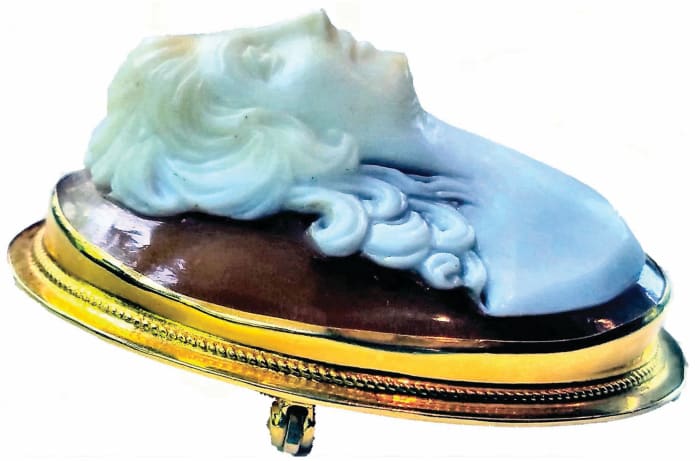
This full-face sardonyx shell cameo clearly shows the pure white image on the rich reddish-brown bottom layer. The contrasting layers of shell are carved in such a way that removes the top layer except for the desired image. The areas removed exposed the underlying darker layer.
Image courtesy of Dr. Anthony Cavo
Stone cameos may be treated with heat or dye to change their natural color to yield desirable background colors such as blue. Cameos may also be carved of one material then applied to a background of contrasting material with adhesives. These two-piece cameos are known as assembled or composite cameos and are not as prized as cameos of contrasting color carved from a single stone.
Examination with a loupe will usually expose the fine line between layers and often the reflective sheen of the adhesive, which is sometimes visible when the glue is pressed out from between the two layers (a solecism). As with all cameos, but especially hardstone, the finer the features and sharper and deeper the detail, the better the cameo.
The shells most prized for carving cameos are those with naturally occurring layers of contrasting color; the Emperor or Queen conch (sardonyx shell) and Helmet shell are highly prized for this reason. The most common shell used for cameos, however, is the carnelian shell and those made of sardonyx shell are the costliest.
Sardonyx shell cameos have a pure white layer over a reddish to rich brown interior and when carved can have a marble-like appearance, whereas carnelian shell cameos range in color from reddish-brown to peach or pale orange.
Lava cameos
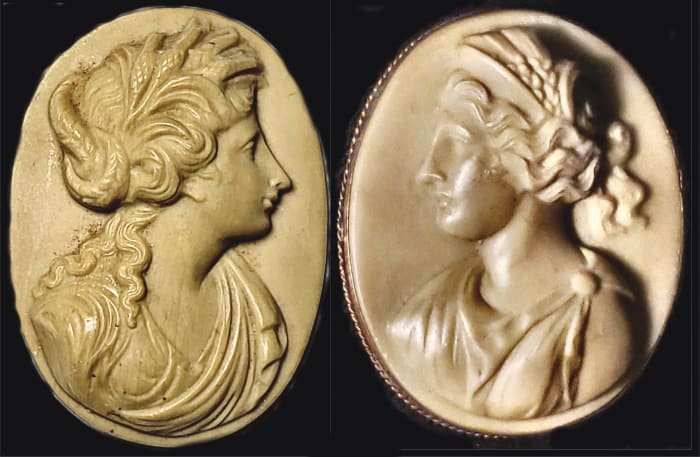
Lava cameos are simple, yet beautiful, monochrome cameos that date back to the seventeenth century. They are made of pyroclastic rock such as tuff or welded tuff or gray, brown, white or putty color igneous rock such as felsite, rhyolite, basalt, or andesite.
Image courtesy of Dr. Anthony Cabo
Lava cameos are simple, yet beautiful, monochrome cameos that date back to the seventeenth century. They are made of pyroclastic rock such as tuff or welded tuff or gray, brown, white or putty color igneous rock such as felsite, rhyolite, basalt, or andesite. These materials are quite abundant and easier to carve than shell or hardstone and were therefore less expensive at the time than either shell or hardstone.
Currently, antique lava cameos rival shell cameos for beauty, desirability and price. Victorians traveling to Italy were eager to obtain and wear one of these unusual pieces, which served as a sign that they were well-traveled. Unfortunately, because lava is not as durable as shell or hardstone, they can easily shatter if dropped; many of them did not survive.
Coral Cameos
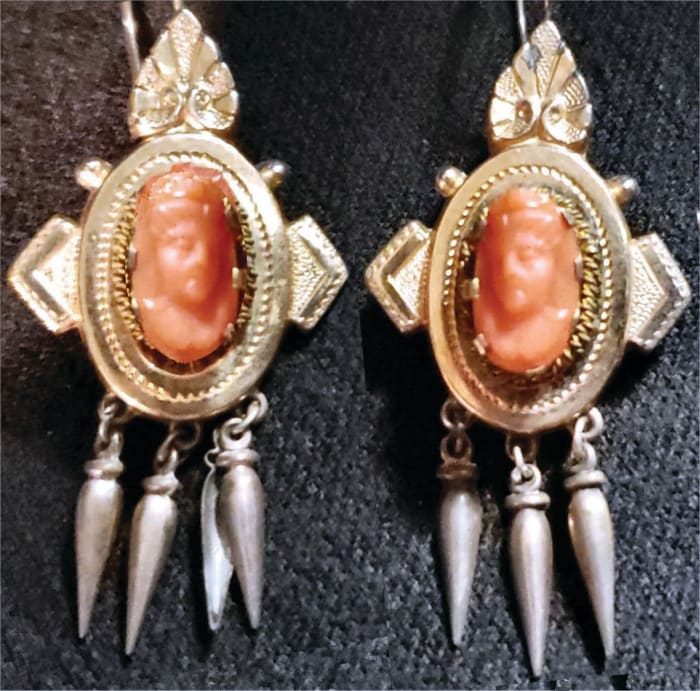
These coral cameo earrings, from the mid-nineteenth century, are set in gold with tassels and anthemion leaf caps.
Image courtesy of Dr. Anthony Cavo
Coral has been used for jewelry production for thousands of years; coral beads were favored by the ancient Egyptians and have been found in many Egyptian tombs in the form of beads.
A variety of cultures from the Egyptians to the Romans and even Victorians considered coral to be an amulet used to ward off evil spirits.
Coral can be found in a variety of colors with the color being determined by the origin, availability of nutrients and water temperature. The most prized of all the coral is the red variety, Corallium rubrum, commonly referred to as noble coral. This is found mainly in the Mediterranean Sea.
Red coral was quite popular during the Victorian era and was fashioned into beads, both round and pendeloque, and other cameo jewelry, especially brooches and earrings.
Angel-skin cameos are those with a pale pink to salmon color. It is often mistakenly assumed that all angel-skin cameos are made of coral (pelle de angelo), when in fact many are made from pink conch or roselyn shell. Close inspection of a coral cameo with a 10X magnification jeweler’s loupe will reveal readily observable growth lines, which are not seen on “angel skin” cameos of shell.
Pink shell cameos fade with exposure to light and many antique pink shell cameos have faded to the point where only a hint of pink remains. These cameos must be stored away from light when not being worn.
Cameo rings have been popular for as long as cameos have been carved with the more popular motifs being Grecian and Roman women and Roman soldiers.

Cameo rings have been popular for as long as cameos have been carved with the more popular motifs being Grecian and Roman women and Roman soldiers. From left to right: sardonyx shell cameo 1920s, 18th century hardstone cameo, early 19th century Roman soldier hardstone cameo, early 19th century hardstone cameo, and a 19th century cameo in jet; gutta percha was also used.
Image courtesy of Dr. Anthony Cavo
Faux cameos
Faux cameos have been made in resin and a variety of plastic including Bakelite, celluloid and thermoplastic – these are all molded cameos. Most faux cameos will have flat backs whereas shell cameos have backs that are curved in a way reminiscent of the bowl of a spoon and a matte finish.
Hand-carved shell cameos will bear growth lines, tool marks and almost facet-like planes that are often visible to the naked eye and certainly apparent with the use of a loupe. When held for about a minute or so, authentic shell or stone cameos will remain cool to the touch while plastic cameos will become warm from body heat.
Beginning about fifty years ago the machine age caught up with cameos when the use of ultrasound to produce cameos gained traction. In her 1991 book, “Cameos: Old & New,” Anna M. Miller wrote that at that time it was estimated that as many as eighty-percent of cameos were being machine-cut by ultrasound in Germany and Japan.
Gerhard Becker, a master cameo carver, described the look of cameos made by ultrasound as having the appearance of “freshly fallen snow.” Tracks or uniform parallel striations, seen across the entire surface of machine-made cameos, can be easily detected with the use of a loupe, especially when viewed from the side. These lines are a major tipoff that the cameo in not hand-carved.
Ultrasound cut cameos also lack undercutting, a cutting technique that is comparable to bas relief. Undercutting adds dimension and produces depth.
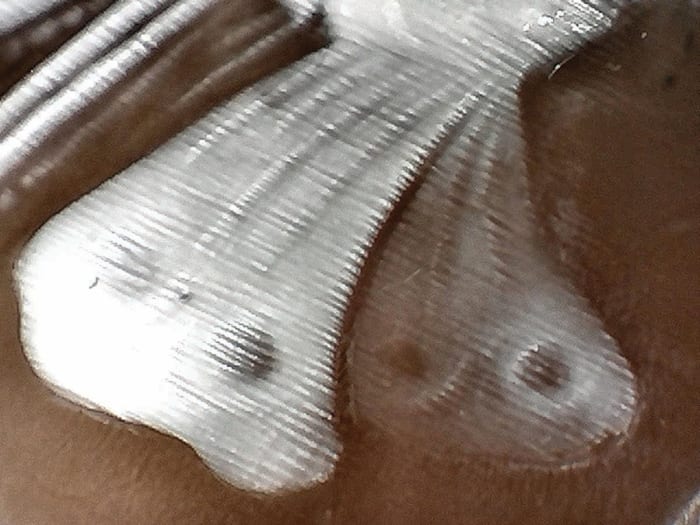
This photo clearly demonstrates the surface of a machine-made cameo. These tracks or uniform parallel striations, seen across the entire surface of machine-made cameos can be easily detected with the use of a loupe, especially when viewed from the side. These lines are a major tipoff that the cameo in not hand-carved.
Image courtesy of Dr. Anthony Cavo
Ultrasound cameos are mass-produced from a hand-carved template and as such are not unique or authentic. The time it takes to produce one of these cameos is minutes as compared to hand-carved cameos that may take many days to months or even a year to complete.
My feeling is that technically and by definition, having been cut into shell, pieces created by ultrasound are cameos but they are not genuine in the sense that they are not created utilizing the thousands of years old method of hand carving. Nor are they, as true cameos are, unique but rather one of a large group of modern, machine-made, minute-made, identical clones.
If you’re in the market for an inexpensive cameo and the idea of uniqueness, depth and hand-carving is not important, then ultrasound-produced cameos may appeal to you; just make sure you are not paying hand-carved prices.
Many of these machine-made cameos are being sold as hand-carved and many dealers aren’t even aware they are selling mass-produced, machine-made pieces.
Nancy Schuring assisted with this article. Nancy founded Devon Fine Jewelry over 40 years ago from a love of jewelry, gemstones and design. She also founded the Devon Foundation to provide lapidary scholarships to young people in gem-rich countries. www.devonfinejewelry.com • www.devonfoundation.com

